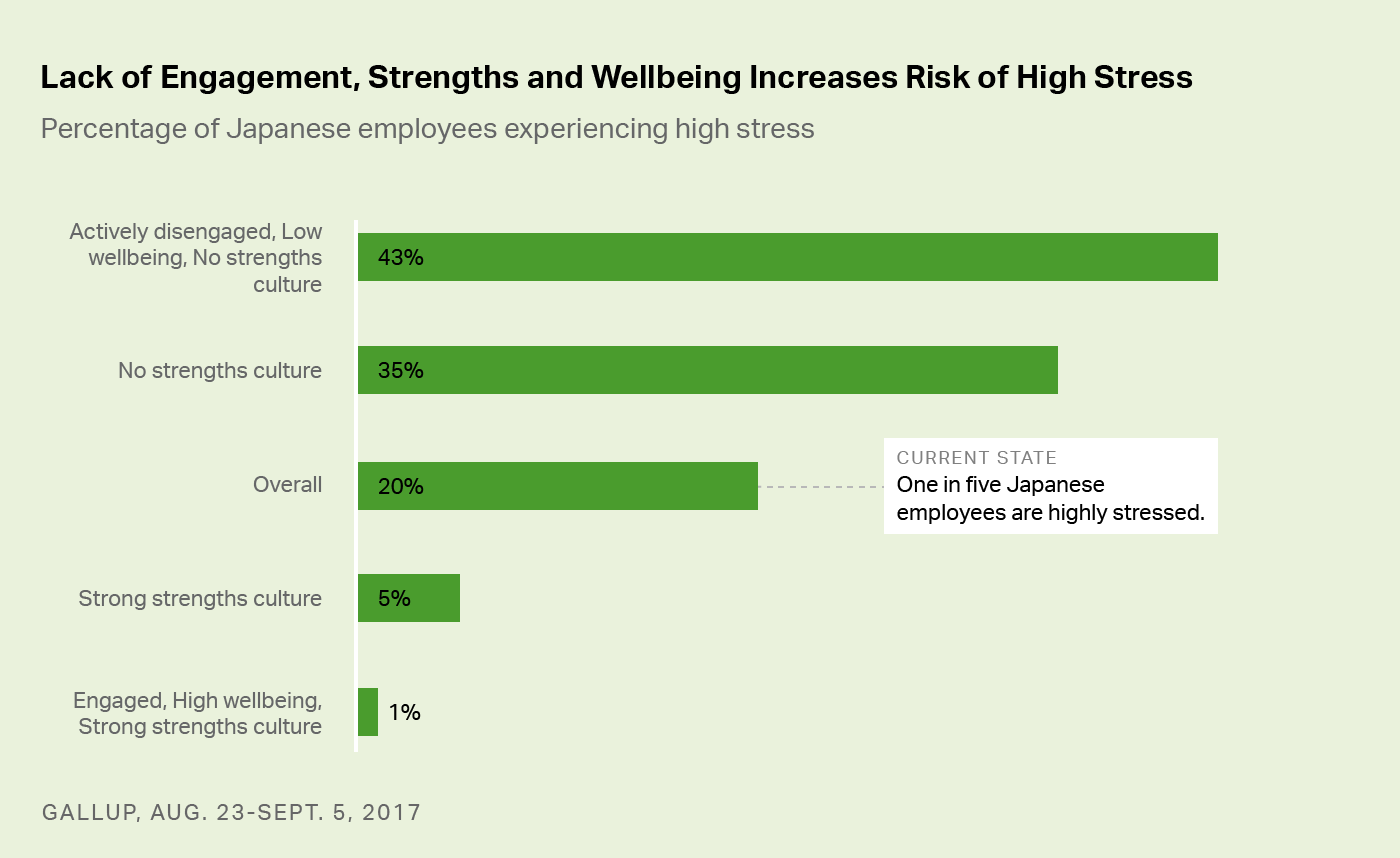Story Highlights
- Companies with fewer stressed workers tend to invest in employees' strengths
- Job burnout is dangerous to both the individual and the employer
- Learn how businesses can thrive when employees know their CliftonStrengths
Gallup has tracked heightened levels of stress and worry in the past few years. Stress and worry can be caused by many things including burnout in the workplace. Addressing and dealing with workplace burnout can help prevent employee burnout in the future.
It's important to remember how quickly workers can burn out, and how dangerous it is to them and their employer. Leaders must do everything in their power to support their employees, especially those most at risk. Gallup's research in Japan on extreme stress at work can help.
The research began in 2017, after the Japanese government released a study showing that over 20% of the Japanese workforce in 2016 was at risk of death from overwork -- known in Japan as karoshi.
In a study of 2,442 Japanese employees, Gallup found that 20% of Japan's working population was experiencing high stress in the workplace linked to extra-long work weeks.
Crushing levels of stress were particularly prevalent among employees who were young, female or unmarried, or those who had less than a college education.
Then Gallup analyzed the relationship of stress to: 1) employee engagement (involvement in and enthusiasm for their work), 2) strengths (productive application of one's capacity for high performance in specific areas), and 3) wellbeing (elements that influence how people think about and experience their overall lives).
After controlling for demographic differences and hours worked per week, Gallup researchers found that engaged employees who love their work and what they do, those who are in workplace cultures that advocate their natural strengths and talents, and those who are thriving in many of the wellbeing elements are significantly less likely to have high stress.

Custom graphic. Bar chart showing how engagement, strengths and wellbeing affect Japanese employees. 43% of those with no strengths culture, low engagement and low wellbeing are highly stressed, compared with 1% of those with a strong strengths culture, high engagement and high wellbeing.
In fact, employee stress was markedly reduced by any one of these three conditions, and was virtually absent among employees benefiting from all three of them: Those who were engaged, worked in cultures that encouraged them to do what they naturally do best and had thriving wellbeing stood a 1% chance of being highly stressed. When those criteria were not met, 43% of workers experienced high stress.
The study also showed that companies with fewer stressed workers tended to invest in their employees' strengths -- helping them understand who they are and what they do best -- and to find ways to help their employees stay healthy.
While we are not suggesting that employee engagement strategies or investing in strengths can wipe away employees' anxieties, we are saying that anxiety is almost certainly higher for employees who are not engaged, are worried about their wellbeing and are working in jobs that don't take advantage of what employees are naturally good at.
The Influence of CliftonStrengths on Reducing Stress
The Japan stress study provides one other perspective on stress -- that it is experienced very differently by people according to their most dominant CliftonStrengths themes.
All of the employees in the study had previously taken the CliftonStrengths assessment, and some people were more accomplished at avoiding stress regardless of their environment. In particular, people strong in the themes of Arranger, Positivity and Self-Assurance experienced less workplace stress, while those with Adaptability, Command, Empathy and Belief were more likely to experience high levels of stress. Interestingly, employees with Belief tended to work longer hours than others, while those with Adaptability tended to work less -- yet both experienced high levels of stress.
It can be tempting to oversimplify the impact of a strengths theme. Thoughts, feelings and behaviors are not controlled by a single theme, and personal predispositions add to or mitigate the experience of stress. CliftonStrengths themes describe intrinsic patterns of behavior rather than predict results or outcomes. Nevertheless, studying the differences in how certain dominant themes show up from one person to the next may offer clues that can help leaders reduce the effect of stress on workers.
In times of great trouble, as the Japan stress study demonstrates, using the insights that CliftonStrengths profiles offer is a best practice for creating work cultures that acknowledge and honor individual strengths. And leaders who use that knowledge can reduce stress for each individual.
The three CliftonStrengths themes most associated with healthy navigation of stress -- Arranger, Positivity and Self-Assurance -- all share a common self-determinist view of the world. A person with Arranger is likelier to manage stress by orchestrating necessary change. A person with Positivity is likelier to take ownership of their emotional environment. People with Self-Assurance look inward for certainty and clarity. Employees in Japan with these themes were better able to thrive than others were because they were inclined to take ownership or responsibility for how work affected them.
In contrast, people with the CliftonStrengths themes associated with higher stress rely upon interaction with other people to make sense of their situation. Adaptability describes a theme of reacting to the urgent needs of others. People with Command come to life when someone needs direction, delegation or defending. People with Empathy understand the world through the emotions they absorb from others. Taking action for something or someone is a peak positive experience for a person with Belief, but it can amplify their stress.
Employees strong in Empathy navigate their environments with six senses. They see, hear, etc. like everyone else does -- but unlike others, they also sense what other people are feeling. Feeling coworkers' stress and fear can easily become overwhelming. Those with Adaptability are in top form when fulfilling other people's needs the moment they need it done. Such people are in great demand during times of high stress, which can be exhausting, even exploitive.
Know Employees' Reactions to High-Stress Environments
Leaders who seek to support workers during this difficult time may find it helpful to understand how those with high-stress CliftonStrengths themes may experience workplace burnout or overload.
Knowing how employees are liable to react helps leaders and managers understand how the environment can affect the individual, for good or ill. That's important information in placid times, when CliftonStrengths themes are often used to outline areas of greatest individual potential and build on it.
While we are not suggesting that employee engagement strategies or investing in strengths can wipe away employees' anxieties, we are saying that anxiety is almost certainly higher for employees who are not engaged, are worried about their wellbeing and are working in jobs that don't take advantage of what employees are naturally good at.
In times of great trouble, as the Japan stress study demonstrates, using the insights that CliftonStrengths profiles offer is a best practice for creating work cultures that acknowledge and honor individual strengths. And leaders who use that knowledge can reduce stress for each individual.
Though the simplest way to reduce stress is to stop causing it, although many situations are beyond any leader's control. But they can focus on that which can be influenced -- and help inoculate employees against further stress. And they should encourage managers to have more conversations (which are a cornerstone of coaching anyway) about positive coping strategies that best fit the individual.
That will help employees, leaders and companies navigate difficult days and come out stronger, as did the Japanese companies that Gallup studied. And it will help leaders make strengths part of their culture. The employees who are struggling right now -- whether because they're most vulnerable to contagion or because they don't know how to succeed in their jobs under unusual circumstances -- need that culture badly.
But really, all employees do. And they always have.
Equip your employees and managers with the tools they need to succeed amid disruption and prevent burnout, starting with CliftonStrengths:
- Better performance starts with a strengths-based culture. Learn how organizations can use CliftonStrengths to succeed.
- Learn the top causes of burnout, the effects and how to stop it at its source.




